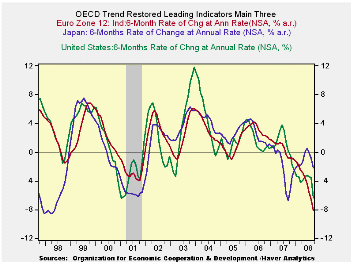 Global| Nov 10 2008
Global| Nov 10 2008OECD Slowdown is Broad-Based and More Severe
Summary
The OECD trend-adjusted cyclical leading indicators showed a clear pattern of growth deteriorating in the OECD region. The downturn is of increasing severity. Even Japan after a brief flirtation with improving is getting weaker again. [...]

The OECD trend-adjusted cyclical leading indicators showed a clear pattern of growth deteriorating in the OECD region. The downturn is of increasing severity. Even Japan after a brief flirtation with improving is getting weaker again. Over 3, 6 and 12 months it is Europe that is now declining the most rapidly.
The OECD prefers to look at these indicators over six months. On that basis the weakness is just as present. As we prepare for the G-20 meeting the OECD area is shrinking rapidly.
Over six months the pace of decline for the OECD is at a rate of 6.5%. Six months ago the six month pace for that index was -2%. One year ago the pace was just -0.8%. And 18n months ago that pace was an increase of 2.5%. All that amounts to a pretty fast drop off. That is the sort of thing that is typical, not of a slowdown, but of a recession.
| OECD Trend-Restored Leading Indicators | ||||
|---|---|---|---|---|
| Growth Progression-SAAR | ||||
| 3Mos | 6Mos | 12mos | Yr-Ago | |
| OECD | -9.8% | -6.5% | -4.3% | 0.8% |
| OECD 7 | -11.1% | -6.7% | -5.0% | 0.0% |
| OECD Europe | -12.1% | -9.2% | -5.8% | 0.2% |
| OECD Japan | -6.8% | -2.3% | 0.0% | -4.0% |
| OECD US | -10.6% | -5.6% | -5.3% | 1.3% |
| Six month readings at 6-Mo Intervals | ||||
| Recent six | 6Mo Ago | 12Mo Ago | 18MO Ago | |
| OECD | -6.5% | -2.0% | -0.8% | 2.5% |
| OECD 7 | -6.7% | -3.2% | -1.2% | 1.3% |
| OECD Europe | -9.2% | -2.3% | -1.0% | 1.3% |
| OECD Japan | -2.3% | 2.2% | -7.8% | -0.1% |
| OECD US | -5.6% | -5.0% | 0.8% | 1.9% |
| Slowdowns indicated by BOLD RED. | ||||
Robert Brusca
AuthorMore in Author Profile »Robert A. Brusca is Chief Economist of Fact and Opinion Economics, a consulting firm he founded in Manhattan. He has been an economist on Wall Street for over 25 years. He has visited central banking and large institutional clients in over 30 countries in his career as an economist. Mr. Brusca was a Divisional Research Chief at the Federal Reserve Bank of NY (Chief of the International Financial markets Division), a Fed Watcher at Irving Trust and Chief Economist at Nikko Securities International. He is widely quoted and appears in various media. Mr. Brusca holds an MA and Ph.D. in economics from Michigan State University and a BA in Economics from the University of Michigan. His research pursues his strong interests in non aligned policy economics as well as international economics. FAO Economics’ research targets investors to assist them in making better investment decisions in stocks, bonds and in a variety of international assets. The company does not manage money and has no conflicts in giving economic advice.






